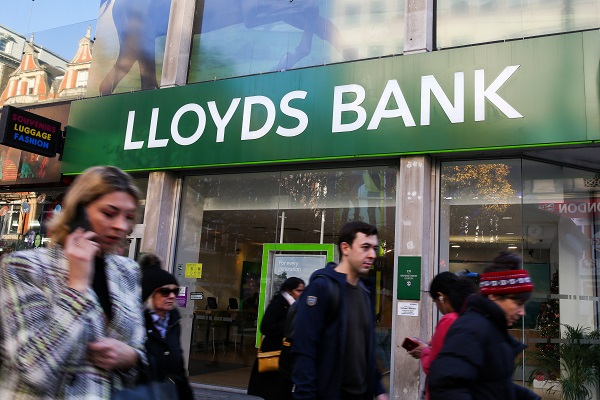Lloyds Bank shares run into profit taking after these results
24th February 2022 08:17
by Richard Hunter from interactive investor
Annual results look solid, but a slightly softer end to the year disappointed investors. Our head of markets looks at the numbers and a new strategy for Lloyds.

Alongside some tidy numbers, Lloyds Banking Group (LSE:LLOY) has announced an ambitious strategy which aims to capitalise on its scale and breadth of both customers and services.
The strategy will build on the company’s growing digital capability, which in itself immediately provides a potentially cheaper rollout since most of the costs are sunk at the initial investment stage.
Across its brands, it aims further to grow its burgeoning mortgage business, as well as a renewed thrust into areas such as home insurance, individual pensions, investments and motor finance. Some of this expansion will target the newly-identified “mass affluent” part of the population, whose income or wealth exceeds £75,000.
The scope for growth is now laid out and clearly sizeable, and the strategy should begin to gain traction over the next couple of years.
A defined strategy is an important part of the evolution of Lloyds, where its UK focus arguably limits some of its growth potential compared to many of its peers, who have strong overseas focus and representation. Even so, some of the themes which have emerged during this reporting season have been mirrored at Lloyds, with a generally strong showing across the key metrics.
- Bank sector results preview: the profits league table
- Is Lloyds the pick of the UK banking bunch?
- Market winners from Russian aggression
- Friends & Family: ii customers can give up to 5 people a free subscription to ii, for just £5 a month extra. Learn more
At the top line, pre-tax profit of £6.9 billion in 2021 compares with a number of £1.2 billion the previous year, propelled by a credit impairment release of £1.2 billion, as opposed to the comparative charge of £4.2 billion at last year’s results.
Interestingly, apart from the release, there has been notable growth, with total income having risen by 28% over the year. While total costs also rose by 12%, and while legacy costs are also an ongoing bugbear, the gap is evident and the cost/income ratio of 56.7% remains comfortably the best in the sector.
Meanwhile, underlying Net Interest Income rose by 4% and, unlike most of its peers, Lloyds was able to increase Net Interest Margin, albeit by a modest amount. The Return on Tangible Equity figure of 13.8% is a significant improvement from the previous year’s 2.3% and the bank is confident of maintain the number somewhere around 10%.
The capital cushion is also comfortably ahead of both regulatory and the bank’s own target, standing at 16.3%. The strength of the bank’s financial position has again been underpinned by a strong showing from mortgage lending growth, which has been accompanied by an expansion of lending to the likes of start-up companies.
This financial strength is also being recognised with a ramping up of shareholder returns. The proposed dividend payment implies a yield of 3.8%which will be of some solace to income-seeking investors, although the yield remains considerably light of pre-pandemic levels. Even so, returns are being boosted further by a proposed share buyback programme of up to £2 billion which, all things being equal, should provide some support to the share price.
Overall, the banks’ reporting season has been a mildly disappointing affair, although more positively the release of credit impairments and generous buyback programmes have been in evidence across the board.
- Stockwatch: a defensive play for worrying time
- Our outlook for 2022: key topics and investment ideas for the year ahead
- Watch our share tips here and subscribe to the ii YouTube channel for free
- Take control of your retirement planning with our award-winning, low-cost Self-Invested Personal Pension (SIPP)
For Lloyds, the share price still has some ground to make up and the weakness of the wider market on geopolitical tensions has put severe pressure on prices generally in early trade. Despite an increase of 33% over the last year, which compares to a hike of 13% for the wider FTSE100, the shares remain down by almost 6% on a two-year view.
Even so, going into the season, Lloyds was the pick of the bunch in terms of market consensus, and the general view of the stock as a "strong buy" is likely to remain intact given the bank’s aspirations and prospects.
These articles are provided for information purposes only. Occasionally, an opinion about whether to buy or sell a specific investment may be provided by third parties. The content is not intended to be a personal recommendation to buy or sell any financial instrument or product, or to adopt any investment strategy as it is not provided based on an assessment of your investing knowledge and experience, your financial situation or your investment objectives. The value of your investments, and the income derived from them, may go down as well as up. You may not get back all the money that you invest. The investments referred to in this article may not be suitable for all investors, and if in doubt, an investor should seek advice from a qualified investment adviser.
Full performance can be found on the company or index summary page on the interactive investor website. Simply click on the company's or index name highlighted in the article.